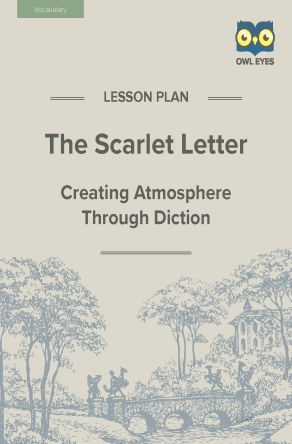The Scarlet Letter Vocabulary Lesson Plan
- 17 pages
- Subject: Setting, Tone, Vocabulary, Lesson Plans and Educational Resources
- Common Core Standards: RL.11-12.1, RL.11-12.4, RL.11-12.5
- Grade Levels: 9, 10, 11, 12
Product Description
Creating Atmosphere through Diction in The Scarlet Letter
This lesson plan focuses on Hawthorne’s diction and its contribution to the atmosphere in the novel. Students will identify the literal and connotative meanings of words found in passages from the novel and examine how they enhance the mysterious, supernatural atmosphere in the text. They will also identify different forms of these words, their synonyms and antonyms, and how they are used in context (parts of speech). In studying Hawthorne’s diction, students will be better able to identify and describe how Hawthorne portrays the three scaffold scenes in the novel.
Skills: close reading, identifying literal meaning, interpreting connotative meaning, examining passages in context
Learning Objectives: By the end of this lesson, students will be able to
- define the literal meanings and interpret the connotative meanings of words in the text.
- analyze and describe how specific word choices create and enhance atmosphere in the novel.
- identify forms of words in the text, their synonyms and antonyms, and their parts of speech.
About This Document
Owl Eyes lesson plans have been developed to meet the demanding needs of today’s educational environment and bridge the gap between online learning and in-class instruction. The main components of each plan include the following:
- An introduction to the text
- A step-by-step guide to lesson procedure
- Previous and following lesson synopses for preparation and extension ideas
- A collection of handouts and worksheets complete with answer keys
Each of these comprehensive, 60-minute plans focus on promoting meaningful interaction, analytical skills, and student-centered activities, drawing from the Common Core Standards for English Language Arts and the expertise of classroom teachers.
Introduction to the Lesson
Nathaniel Hawthorne’s American classic The Scarlet Letter explores the complicated effects of secrecy and guilt in 17-century Boston, a city governed by strict Puritan law.
One of the first American psychological novels, the story relates the events surrounding the life of Hester Prynne, a Puritan woman whom the town convicts of adultery. As part of her punishment, she is forced to wear a scarlet letter “A” for all to see. Hawthorne sympathetically depicts Hester’s struggle wearing the letter, her challenges raising a daughter as a single mother, and her relationship with the Reverend Arthur Dimmesdale, her former lover. Hester’s dignity and grace in spite of her rejected position sharply contrasts with the deceit and shame of Dimmesdale, whose guilt and hidden sin provide the driving tension of the novel.
Hawthorne relates the events of The Scarlet Letter through an unnamed narrator who discovers the tattered cloth “A” and a parchment with part of Hester Prynne’s story on it. The unnamed narrator’s rendition of the tale situates it in a shadowy and obscure past that separates readers from present reality. This frame story makes it easier for readers to suspend their disbelief in interpreting the mysterious and otherworldly elements present in the narrative.
Worksheet Excerpt
“Examining Diction and Atmosphere in Chapter XII”
As a group, discuss the following questions and reach a consensus in answering them, with everyone contributing information and ideas. Make notes on your handout during the discussion. Have the Recorder in your group write down what your group decides is the best response to each of the questions. The Reporter in your group will share your conclusions with the class.
-
What is the setting in the chapter (time and place)?
-
Who stands on the scaffold?
-
What spectacular event occurs in the sky, and how does it affect the setting?
-
Here is a list of words from the chapter, along with their literal (explicit) meanings. Below each word, record some of its connotative or emotional meanings and what we often associate with the word. The first one has been done as an example.
Shadow: a dark area or shape produced by a body coming between rays of light and a surface. Connotations: oppressiveness; sadness; gloom; danger
Grey (gray): a color intermediate between black and white
Connotations: ____________________________________________________________
Bloody: covered, smeared, or running with blood
Connotations: ____________________________________________________________
Poisonous: causing or capable of causing illness or death
Connotations: ____________________________________________________________
Devils and witches: supernatural beings who possess supernatural powers
Connotations: ____________________________________________________________
Ghost: an apparition of a dead person
Connotations: ____________________________________________________________
Shrieked: uttered words or cried out with a high-pitched, piercing sound
Connotations: ____________________________________________________________
- Based on Hawthorne’s diction (word choice) in the chapter, how would you describe the atmosphere in this scene at the scaffold?







